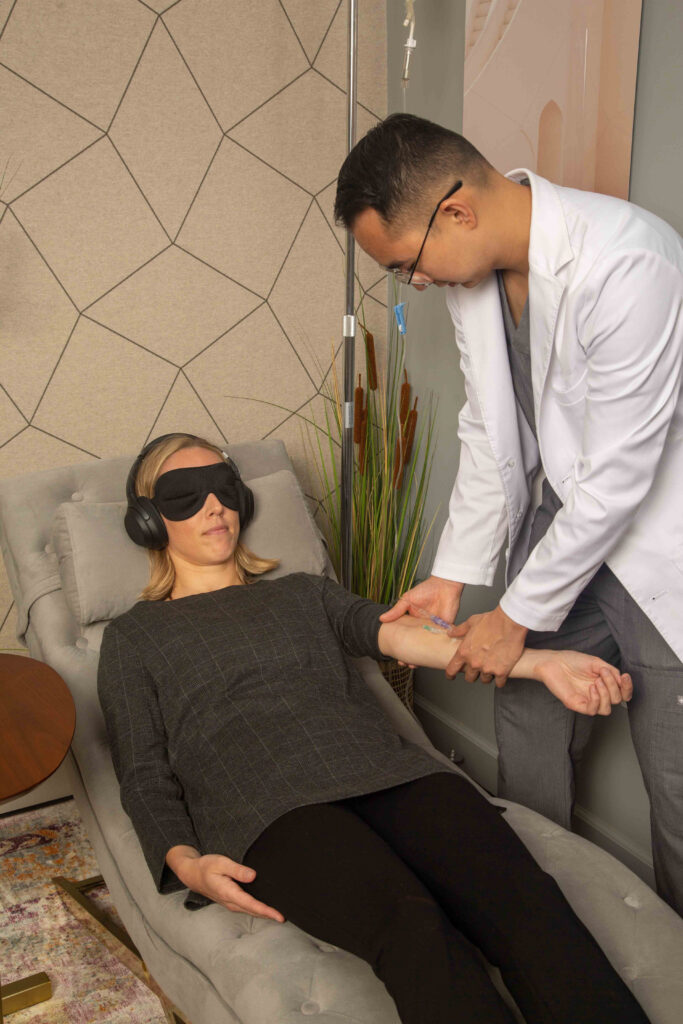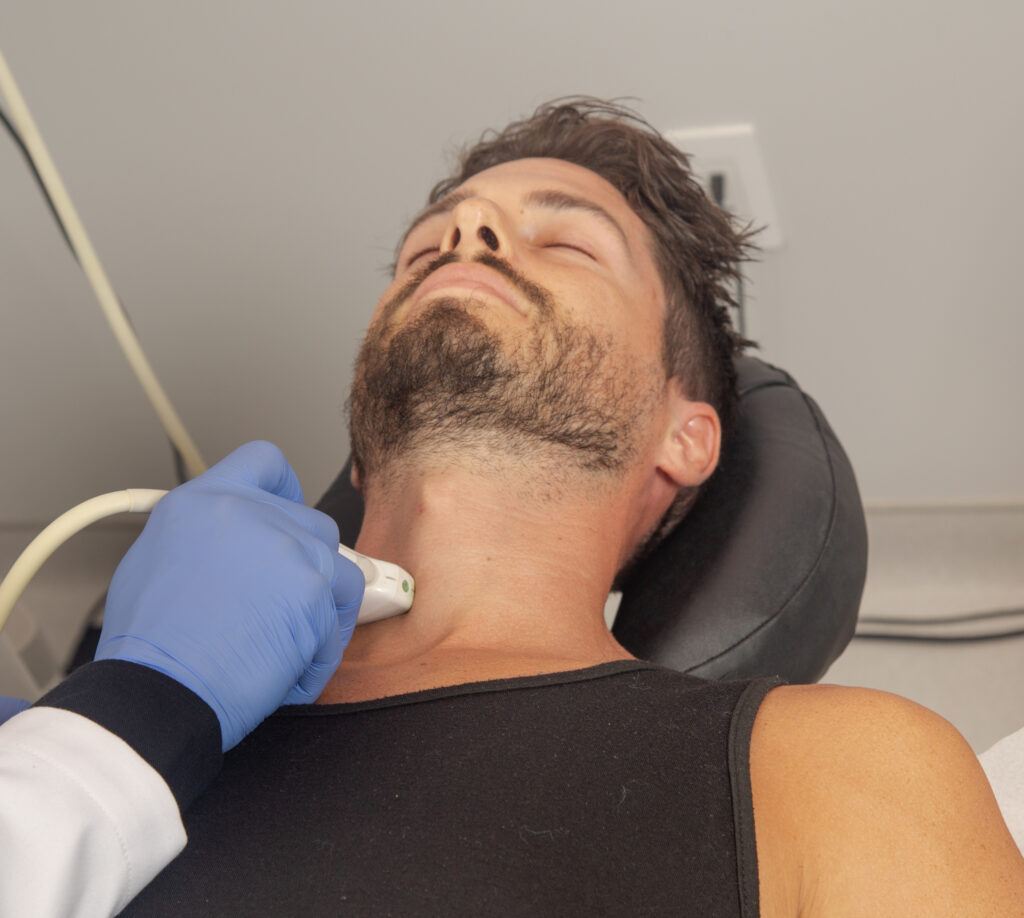Written by: Tabitha Block, Jonathann Kuo MD
Interventional Mental Health is a new specialty of medicine that seeks to use specialized procedures to treat mental health disorders. Some patients struggling with mental health disorders may find that conventional therapies such as pharmacotherapies and psychotherapies do not produce sufficient relief of their symptoms. At Hudson Medical, our team of physicians work in conjunction with your mental health professionals to derive treatment plans tailored to specific conditions, such as Anxiety, Post-Traumatic Stress Disorder (PTSD), and Depression. We provide intervention-assisted mindfulness-based treatment options with synergistic and potentiated therapeutic benefits.
What is Anxiety?
Anxiety is one of the most common psychiatric disorders and is linked to both biopsychosocial and genetic factors (1). Research suggests that the COVID-19 pandemic substantially increased the estimated global prevalence of anxiety from 7.3% to 25% (2). As there are multiple subtypes of anxiety disorders, symptoms can present in diverse ways, but characteristic symptoms of anxiety disorders include cognitive symptoms (e.g. fear of losing control, fear of physical injury, confusion, etc), physiological symptoms (e.g. increased heart rate, shortness of breath, chest pain, sweating, nausea, trembling, etc), behavioral symptoms (e.g. pacing, hyperventilation, etc), and affective symptoms (e.g. nervousness, fear, frustration, etc)(1).
What causes Anxiety Disorders?
Although there are many contributing factors to anxiety disorders, many of the cognitive, physiological, and behavioral symptoms consistent with these conditions stem from overstimulation of a perceived threat(s) (1). As the fear response to perceived threats is involuntary, nervous system hypersensitivity may exacerbate anxiety symptoms and contributes to anxiety disorder pathophysiology (3).
The nervous system has two branches, the sympathetic nervous system (SNS) and the parasympathetic nervous system (PNS), which control physiological and behavioral responses to stimuli. The SNS delivers information about stress, impending danger and fear to the brain so the body can respond to these signals, a process commonly called the “fight-or-flight” response. Alternatively, the PNS opposes the actions of the SNS in order to maintain a steady-state and is commonly known as the “rest-and-digest” response. Under normal conditions, the SNS elicits appropriate responses to stressful stimuli, such as an increase in sweating and heart rate while slamming on the brakes to avoid a car accident. The SNS is essential for survival because these responses liberate extra energy and equip the body to deal with emergency situations. Despite this vital role, overstimulation or dysregulation of the SNS can lead to dysfunctional and inappropriate physiological responses (i.e. dysautonomia) (4). Dysautonomia is characterized by abnormal activity of involuntary body functions that are regulated by the SNS, such as heart rate, breathing and digestion. Dysautonomia can have detrimental effects on myriad organ systems and can severely impair quality of life (5).
Patients with anxiety disorders experience heightened SNS responses under resting conditions and in response to stressors (4, 7-9). These magnified “fight-or-flight” responses contribute to many symptoms of anxiety disorders (7-9).
How are Anxiety Disorders treated?
Anxiety disorders are traditionally treated with psychological therapy, pharmacotherapy, or a combination of both (10). Although many patients with anxiety find significant symptom relief following cognitive behavioral therapy and/or medications such as selective serotonin reuptake inhibitors (SSRIs) and serotonin-norepinephrine reuptake inhibitors (SNRIs), a subset of patients continue to experience anxiety symptoms following these treatment modalities or discontinue pharmacotherapy due to severe side effects (10-11). For such patients, traditional treatments do not provide sufficient symptom relief, and continuation of anxiety symptoms can have significant social and economic consequences.
Fortunately, neuroscience research has revealed a new therapeutic avenue for individuals with anxiety – the Stellate Ganglion Block (SGB). The SGB procedure is able to successfully treat anxiety and PTSD symptoms by anesthetizing the physical source of trauma-related symptom sympathetic overdrive, the stellate ganglion nerve cluster (SG). SGB effectively “reset” the sympathetic nervous system and restore normal biological function, providing patients with rapid and significant symptom relief of even the most severe anxiety symptoms.
What are Stellate Ganglion Blocks?
For many years, SGB has been safely and widely used as a minimally-invasive treatment option for many medical conditions ranging from peripheral vascular disease to refractory ventricular tachycardia to complex regional pain syndrome (12-14). More recently, however, SGB has been shown to produce significant and long-lasting symptom relief for psychiatric conditions such as anxiety and PTSD as well as post-acute COVID-19 syndrome (14-18). SGB works by anesthetizing the stellate ganglion (SG), a nerve cluster associated with “fight-or-flight” responses to impending danger and fear. The SG is located in the upper neck and coordinates with the central nervous system to produce sympathetic responses. SGB attenuates sympathetic outflow from the SG and provides anxiety symptom relief by restoring dysregulated SNS signaling. When used in conjunction with psychotherapy, SGBs have a 70%-80% success rate in treating anxiety and PTSD symptoms (16, 19-20).
What happens during a Stellate Ganglion Block?
SGB is a highly effective and safe minimally-invasive outpatient procedure performed under monitored care anesthesia (light sedation). Using X-ray fluoroscopy and ultrasound, your physician will guide a small needle into the neck region that contains the stellate ganglion nerve cluster. Once the needle position is confirmed, a local numbing anesthetic (e.g. bupivacaine or lidocaine) is injected into the stellate ganglion. The entire procedure is performed under ultrasound guidance and takes an average of 20 minutes to complete (20).
Successful SGBs will elicit a physiological response known as “Horner’s Syndrome” (19). Horner’s Syndrome may include facial flushing, ipsilateral ptosis (drooping of the eye on the same side the SGB was performed), meiosis (decreased pupil size), eye redness, reduced sweating and hoarseness (19). This response typically lasts between 4-8 hours and, in the vast majority of cases, will subside by the following day. Your physician will monitor you for evidence of Horner’s Syndrome for about 15 minutes after the completion of your procedure.
CITATIONS:
- Chand SP, Marwaha R. Anxiety. [Updated 2022 Feb 7]. In: StatPearls [Internet]. Treasure Island (FL): StatPearls Publishing; 2022 Jan-. Available from: https://www.ncbi.nlm.nih.gov/books/NBK470361/
- Santabárbara J, Lasheras I, Lipnicki DM, et al. Prevalence of anxiety in the COVID-19 pandemic: An updated meta-analysis of community-based studies. Prog Neuropsychopharmacol Biol Psychiatry. 2021;109:110207. doi:10.1016/j.pnpbp.2020.110207
- Wenner, Megan M. “Sympathetic activation in chronic anxiety: not just at the “height” of stress. Editorial Focus on “Relative burst amplitude of muscle sympathetic nerve activity is an indicator of altered sympathetic outflow in chronic anxiety”.” Journal of neurophysiology vol. 120,1 (2018): 7-8. doi:10.1152/jn.00220.2018
- Alshak, Mark N. and Joe M Das. “Neuroanatomy, Sympathetic Nervous System.” StatPearls, StatPearls Publishing, 26 July 2021.
- Goldstein, B. “Anatomy of the peripheral nervous system.” Physical medicine and rehabilitation clinics of North America vol. 12,2 (2001): 207-36.
- Chaudhry, A et al. “Detection of the Stellate and Thoracic Sympathetic Chain Ganglia with High-Resolution 3D-CISS MR Imaging.” AJNR. American journal of neuroradiology vol. 39,8 (2018): 1550-1554. doi:10.3174/ajnr.A5698
- Ho TC, Pham HT, Miller JG, Kircanski K, Gotlib IH. Sympathetic nervous system dominance during stress recovery mediates associations between stress sensitivity and social anxiety symptoms in female adolescents. Dev Psychopathol. 2020;32(5):1914-1925. doi:10.1017/S0954579420001261
- Fonkoue, Ida T et al. “Symptom severity impacts sympathetic dysregulation and inflammation in post-traumatic stress disorder (PTSD).” Brain, behavior, and immunity vol. 83 (2020): 260-269. doi:10.1016/j.bbi.2019.10.021
- Patriquin MA, Mathew SJ. The Neurobiological Mechanisms of Generalized Anxiety Disorder and Chronic Stress. Chronic Stress (Thousand Oaks). 2017;1:2470547017703993. doi:10.1177/2470547017703993
- Bandelow B, Michaelis S, Wedekind D. Treatment of anxiety disorders. Dialogues Clin Neurosci. 2017;19(2):93-107. doi:10.31887/DCNS.2017.19.2/bbandelow
- Braund TA, Tillman G, Palmer DM, Gordon E, Rush AJ, Harris AWF. Antidepressant side effects and their impact on treatment outcome in people with major depressive disorder: an iSPOT-D report. Transl Psychiatry. 2021;11(1):417. Published 2021 Aug 4. doi:10.1038/s41398-021-01533-1
- Rajesh, M C et al. “Stellate Ganglion Block as Rescue Therapy in Refractory Ventricular Tachycardia.” Anesthesia, essays and researches vol. 11,1 (2017): 266-267. doi:10.4103/0259-1162.194566
- Tian, Ying et al. “Effective Use of Percutaneous Stellate Ganglion Blockade in Patients With Electrical Storm.” Circulation. Arrhythmia and electrophysiology vol. 12,9 (2019): e007118. doi:10.1161/CIRCEP.118.007118
- Datta, Rashmi et al. “A study of the efficacy of stellate ganglion blocks in complex regional pain syndromes of the upper body.” Journal of anaesthesiology, clinical pharmacology vol. 33,4 (2017): 534-540. doi:10.4103/joacp.JOACP_326_16
- Lipov, Eugene G et al. “Stellate ganglion block improves refractory post-traumatic stress disorder and associated memory dysfunction: a case report and systematic literature review.” Military medicine vol. 178,2 (2013): e260-4. doi:10.7205/MILMED-D-12-00290
- Lynch, James H. “Stellate ganglion block treats posttraumatic stress: An example of precision mental health.” Brain and behavior vol. 10,11 (2020): e01807. doi:10.1002/brb3.1807
- Summers, Mary R, and Remington L Nevin. “Stellate Ganglion Block in the Treatment of Post-traumatic Stress Disorder: A Review of Historical and Recent Literature.” Pain practice : the official journal of World Institute of Pain vol. 17,4 (2017): 546-553. doi:10.1111/papr.12503
- Liu LD, Duricka DL. Stellate ganglion block reduces symptoms of Long COVID: A case series. J Neuroimmunol. 2022;362:577784. doi:10.1016/j.jneuroim.2021.577784
- Mulvaney, Sean W et al. “Stellate ganglion block used to treat symptoms associated with combat-related post-traumatic stress disorder: a case series of 166 patients.” Military medicine vol. 179,10 (2014): 1133-40. doi:10.7205/MILMED-D-14-00151
- Lynch, James H et al. “Effect of Stellate Ganglion Block on Specific Symptom Clusters for Treatment of Post-Traumatic Stress Disorder.” Military medicine vol. 181,9 (2016): 1135-41. doi:10.7205/MILMED-D-15-00518


